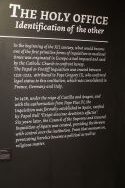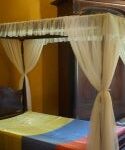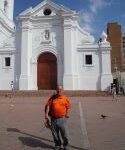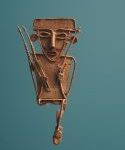December 24, 2016
I’m waiting for Santa, who is less apparent here than in Bloomington; perhaps he can’t find a suit to suit this weather. This is no place for heavy winter clothing.

 If you saw my Facebook post, you have a pretty good idea of what we’ve been up to, or at least me. Yesterday, we “hung” around the Museum of the Inquisition, which was part of Spain’s efforts to combat heresy everywhere. There were three offices in the New World (the others at Lima and Mexico City), that lasted as long as Spanish rule did. The head of the Inquisition had more power than either the governor-general, or the commandant, which surprised me.
If you saw my Facebook post, you have a pretty good idea of what we’ve been up to, or at least me. Yesterday, we “hung” around the Museum of the Inquisition, which was part of Spain’s efforts to combat heresy everywhere. There were three offices in the New World (the others at Lima and Mexico City), that lasted as long as Spanish rule did. The head of the Inquisition had more power than either the governor-general, or the commandant, which surprised me.
You could be hailed before the Inquisition for almost any kind of offense against the Church—which included being Protestant or Jewish (a lot of Spanish Jews converted after Ferdinand and Isabella unified Spain, but still were suspect), blasphemous, having banned books (including Kant)…and while there were a lot fewer incarcerations or deaths in Cartagena, the Inquisition lasted over 200 years. I put it in perspective of what I saw/read about Roger Williams and the early years of the Massachusetts Bay colony, where there was also little tolerance for dissenters (and this was done by dissenters, who left England to practice their own religion).
The museum has some suspicious instruments of torture. There’s a guillotine, but that was not used. There’s a gallows (hence the hanging  around comment), and that was used here, but the usual sentence of death was carried out by burning at the stake; that was presumed to be the only way to reclaim the lost soul.
around comment), and that was used here, but the usual sentence of death was carried out by burning at the stake; that was presumed to be the only way to reclaim the lost soul.
I had the chance today to go on a tour to Santa Marta, about 200 miles up the coast (or as the Spanish called the north coast, Terra Firma). I went. Santa Marta predates the founding of Cartagena by about 6 years. The Spanish there found Indians with gold jewelry—apparently gold is loose in the local river, which “sold” the Spanish on the region.

 There were two main sites I wanted to see. The first was where Simon Bolivar died. Bolivar, a Venezuelan, was one of the premier leaders in the insurrection which ended Spanish rule. He was born in Caracas, but helped free what are now six countries in northern South America. He died of tuberculosis at the age of 47. The estate of his friend had a major sugar cane plantation (for the making of rum, which was one element in the slave trade). The home is partly a shrine of Bolivar. It is also an arboretum, with a number of century old trees, not all of which are local; there’s a huge fig tree of the type that I’ve seen in Angkor Wat. There’s also snakes in the arboretum, with a caveat not to go into the pristine areas since there are poisonous snakes waiting ….
There were two main sites I wanted to see. The first was where Simon Bolivar died. Bolivar, a Venezuelan, was one of the premier leaders in the insurrection which ended Spanish rule. He was born in Caracas, but helped free what are now six countries in northern South America. He died of tuberculosis at the age of 47. The estate of his friend had a major sugar cane plantation (for the making of rum, which was one element in the slave trade). The home is partly a shrine of Bolivar. It is also an arboretum, with a number of century old trees, not all of which are local; there’s a huge fig tree of the type that I’ve seen in Angkor Wat. There’s also snakes in the arboretum, with a caveat not to go into the pristine areas since there are poisonous snakes waiting ….
The other site was the old town. To my dismay, the “other site” on the tour was a swim in the ocean. I was the only English speaker on the bus, and my nearly 60 year old Spanish might not get me through my high school class. The guide spoke no English, but one of the tourists (from the Dominican Republic) helped me convince the guide to get a cab to take me to the old section. The guide (who habla espanol only!) offered to come with and get me there and back.
 I had about an hour and a half to wander what is a less upscale version of Cartagena (and totally without walls or fortresses), with a number of colonial houses, government buildings that date back to the colonial or early Republican period. All went well (though I was disappointed by the gold museum—which had some Indian jewelry, and was in the former customs house) until it was time to leave. I went back to the Cathedral (supposedly the oldest in South America)
I had about an hour and a half to wander what is a less upscale version of Cartagena (and totally without walls or fortresses), with a number of colonial houses, government buildings that date back to the colonial or early Republican period. All went well (though I was disappointed by the gold museum—which had some Indian jewelry, and was in the former customs house) until it was time to leave. I went back to the Cathedral (supposedly the oldest in South America) since the guide firmly said, “aqui, tres.” “Tres” came and went. Tres fifteen I started thinking about where I was going to spend the night or how I would get back to Cartagena. Finally, she appeared with her husband (the bus driver) , laden with a shopping bag full of recent purchases.
since the guide firmly said, “aqui, tres.” “Tres” came and went. Tres fifteen I started thinking about where I was going to spend the night or how I would get back to Cartagena. Finally, she appeared with her husband (the bus driver) , laden with a shopping bag full of recent purchases.
I got out my English-Spanish dictionary and pointed out the word, “worried.” She understood that!
Feliz navidad and a merry Christmas and happy Hanukkah.